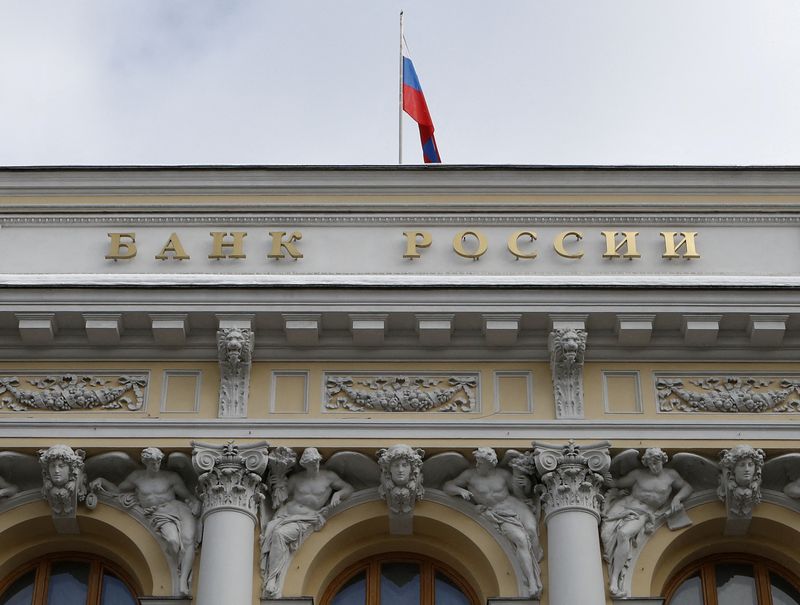By Alexander Marrow
MOSCOW (Reuters) -Russia's central bank on Friday warned that further widening of the country's budget deficit may compel it to raise interest rates, sending a hawkish signal as it kept the cost of borrowing unchanged but adjusted forecasts for the year ahead.
Russia recorded a budget deficit of almost $25 billion in January, as expenditures soared and revenues slumped, in large part due to falling oil and gas revenues, the lifeblood of Russia's economy.
That has coincided with the returning scourge of price growth in recent weeks, limiting room to cut rates and foster economic growth. Governor Elvira Nabiullina told a news conference that the pace of price growth in January was probably the highest since last April.
Dressed predominately in black, as she has been at most public appearances since Russia sent tens of thousands of troops into Ukraine last February, Nabiullina said the balance of risks had shifted towards inflation.
"Accelerating fiscal spending, deteriorating terms of foreign trade and (the) situation in the labour market intensify pro-inflation risks," the bank said in a statement.
Last year, the bank gradually reversed an emergency rate hike to 20% made in late February after the Ukraine conflict began and wide-ranging Western sanctions were imposed in response. It has held rates steady at 7.5% since the last cut in September.
While noting an increase in short-term inflation risks, the bank kept its year-end inflation forecast at 5.0-7.0%, retaining hopes that it can return to its 4% target in 2024. Annual inflation was running at 11.8% as of Feb. 6, it said.
"If pro-inflation risks intensify, the Bank of Russia will consider the necessity of a key rate increase at its upcoming meetings," the bank said.
The bank now sees its key rate in the 7.0%-9.0% range this year, up from 6.5%-8.5% in the previous forecast.
BUDGET DEFICIT
After an estimated GDP contraction of 2.5% last year as Western sanctions took their toll, Russia's economic outlook for 2023 appears brighter, but labour shortages, falling energy revenues and the widening deficit all pose challenges.
"In case of a further budget deficit expansion, pro-inflation risks will rise and tighter monetary policy may be required," the bank said.
It adjusted its 2023 GDP forecast to between growth of 1.0% and a contraction of 1.0%, from a 1.0%-4.0% decline previously. The International Monetary Fund expects the Russian economy to grow 0.3% this year.
"As for GDP dynamics, quarterly dynamics are already positive in the third and fourth quarters. If we talk about annual indicators, in our opinion, GDP will move into positive territory in the middle of the year," Nabiullina said.
The combination of lower export prices for Russian oil and recovering imports also prompted a downward revision of the bank's forecast for Russia's 2023 current account surplus, to $66 billion from $123 billion.
EYES ON OIL PRICE
Friday's decision came in line with a Reuters poll of analysts, who expected both the more hawkish signal and the unchanged rate.
The central bank also lowered its assessment of the average Urals oil price for 2023 in light of embargoes on Russian crude and oil products imposed by Western countries over Russia's actions in Ukraine, to $55 per barrel from $70.10.
That has implications for Russia's 2023 budget, which is currently based on the $70.10 price.

Nabiullina said the bank would monitor the impact on oil prices of the Russian government's decision on Friday to cut crude oil production by 500,000 barrels per day from March.
The next rate-setting meeting is scheduled for March 17.